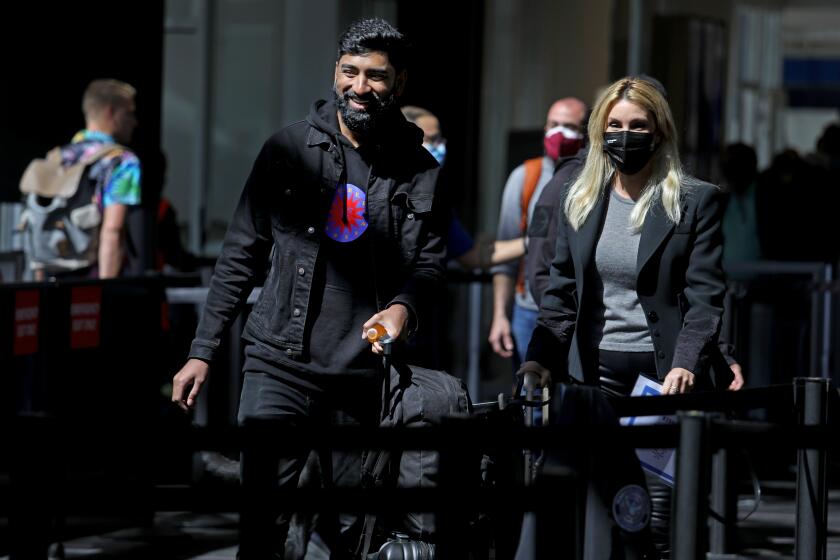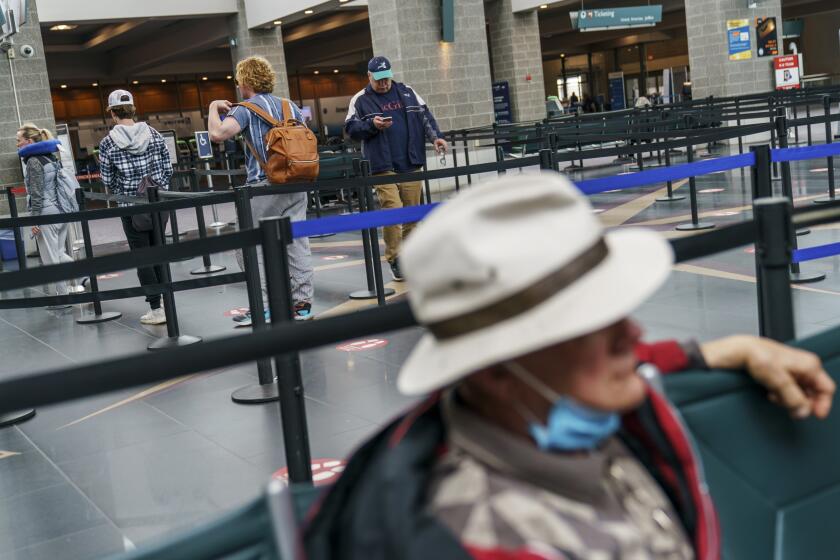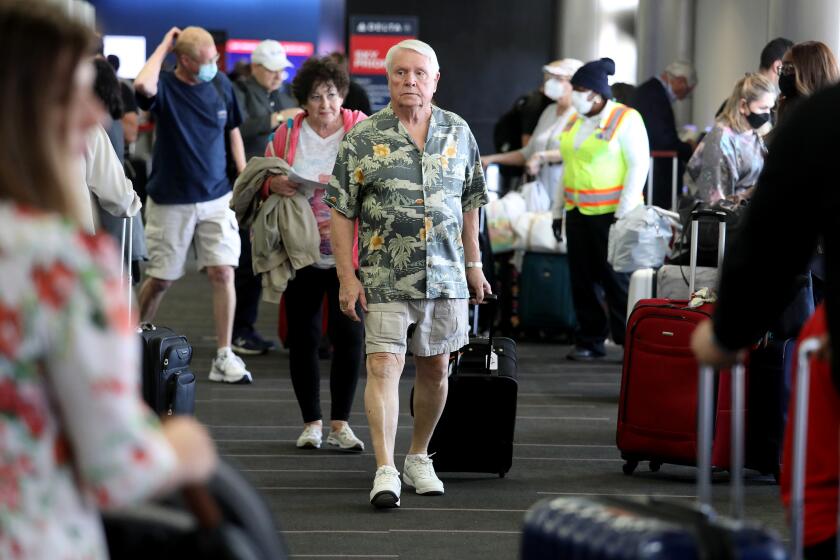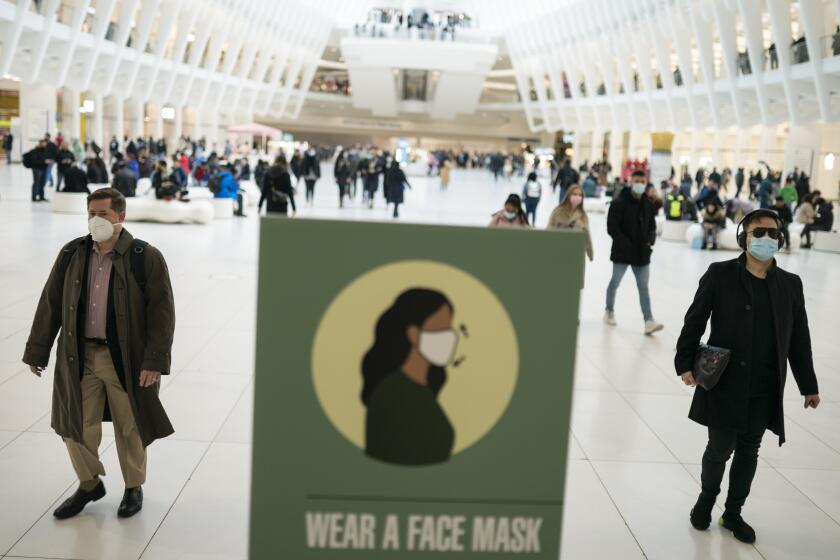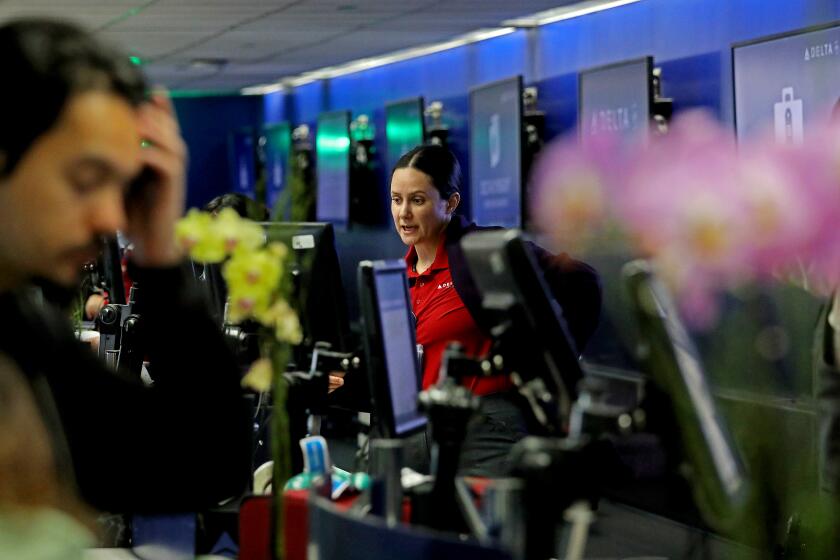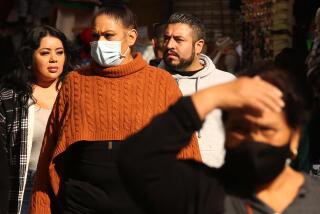L.A. County keeps mask mandate at airports, on public transit, despite federal changes

- Share via
Despite recent changes at the federal level, Los Angeles County is continuing to require travelers to mask up when aboard public transit or in indoor transportation hubs such as airports.
The new health officer order, which went into effect at 12:01 a.m. Friday, means the nation’s most populous county again has face-covering rules that go beyond those set by the state.
On Wednesday, the California Department of Public Health unveiled its own updated guidance that strongly recommends residents mask up when using public transit, though it’s no longer required.
L.A. County’s mask order covers commuter trains, subways, buses, taxis, Ubers and Lyfts; as well as indoor transportation hubs, including bus terminals, subway stations, seaports and other indoor port terminals, according to Public Health Director Barbara Ferrer. It applies to everyone ages 2 and older, regardless of their COVID-19 vaccination status.
The order affects Los Angeles International Airport and Hollywood Burbank Airport. Ferrer said she expects the Long Beach public health department, which operates independently of the county, to adopt a similar order. Pasadena, which also has its own public health agency, confirmed it will align with the county’s mask-wearing rules.
Welcome to the mask-optional phase of the pandemic. It brings freedoms and risks
The local mask-wearing order applies to airline passengers once they disembark their plane and does not extend to people once they have boarded.
Local transit agencies began announcing the return of mask orders on public transportation. Mask use became optional on the Metrolink commuter rail system Monday night and L.A. County’s Metro system Tuesday, but mask wearing was again required starting Friday.
In opting to maintain the mandate, Ferrer cited both the continued elevated level of coronavirus transmission countywide and a recent assessment from the U.S. Centers for Disease Control and Prevention that, “at this time, an order requiring masking in the indoor transportation corridor remains necessary for the public health.”
“That resonates with us,” Ferrer told reporters during a briefing Thursday. “We think and agree that public transit settings ... and public transportation hubs that are indoors are places where, A) There’s a lot of mingling; B) They’re often crowded; and C) In some of those settings, it’s really hard to have adequate ventilation.
“As soon as CDC determined that it was important to keep this masking requirement in place, we went ahead and aligned with the CDC,” she added.
The CDC had intended to keep the federal mask order on public transportation systems such as buses, trains and airplanes in place at least until May 3, pending further review of increasing coronavirus cases nationally. But that timeline was upended by a court ruling striking down the mandate earlier this week.
The Justice Department has since moved to appeal the decision.
The Justice Department is filing an appeal seeking to overturn a judge’s order that voided the federal mask mandate on planes, trains and travel hubs.
Ferrer said this latest health order is not meant as a precursor to the reinstitution of broader mask mandates, such as in schools or other indoor public settings.
She did, however, acknowledge that some residents may feel a touch of whiplash as many airlines, transit systems and commuting companies, including Uber and Lyft, announced they would lift masking requirements for passengers following the court ruling.
“I think it’s important to note that the CDC did not change their requirements/recommendation, their guidance,” Ferrer said. “A judge, a federal judge with little experience in public health, actually determined that and questioned ... whether CDC had the authority to issue that regulation.”
L.A. County is not the first local entity to require mask use on public transit in the aftermath of Monday’s federal court ruling. On Tuesday, the Port Authority of New York and New Jersey said the mask mandate would remain in effect at John F. Kennedy and LaGuardia airports in New York City, based on local public health guidance.
New York Gov. Kathy Hochul said Tuesday that masks are still required on New York City’s subway and bus system, in accordance with recommendations from public health officials.
The transit agency that serves Milwaukee County in Wisconsin has also retained a mask-wearing order on its bus system.
Officials acknowledge it’s not ideal to have local orders at odds with other areas of the country but blamed the mismatch of masking policies on the judicial action.
“While it would be much [more] preferable to have — as the CDC had previously mandated — a requirement that covers the entire country until the legal challenges are addressed, it’s important that local jurisdictions take direction from the CDC on what measures are needed to protect the public health,” Ferrer said.
“This was not a decision by the federal government that masks were no longer needed in very congested settings like public transit, our buses, in New York City, the subway. But it was overturned by the court for procedural reasons,” Hochul said Wednesday.
Many experts stress that face coverings still protect against the coronavirus and that masking up makes sense — even if it’s no longer mandatory.
Ferrer also expressed concern about recent increases in the county’s coronavirus case and test positivity rates. Over the last week, L.A. County averaged 1,262 new cases a day, more than double the rate recorded a month ago.
The coronavirus positivity rate also has increased to about 2% in recent days; two weeks ago, the positivity rate was about 1%.
An additional point of concern is the rapidly spreading BA.2 subvariant of the Omicron variant in L.A. County, which now dominates sequenced coronavirus cases.
The latest case rate is equivalent to 87 cases a week for every 100,000 residents, meaning the county is seeing a substantial level of coronavirus transmission. L.A. County would need to drop to a rate of fewer than 50 cases a week for every 100,000 residents, or fewer than 730 cases a day, to return to a moderate level of transmission.
Ferrer said the county order will be reassessed when community transmission falls back to the moderate level, when the CDC determines transit masking is no longer necessary, or in 30 days, whichever happens first.
“While many of us would like to be at a place where masking is no longer necessary, with substantial transmission and a more infectious variant, one of the easiest things we can do to prevent infection is to wear a well-fitting mask or respirator,” she said.
Ferrer added that the county will continue to employ an education-emphasis approach to promote compliance, rather than heavy-handed enforcement.
“Our experience to date is that the vast majority of people follow these sensible rules. They take to heart the fact that these are put in place so that we can go on with the business of protecting each other and keeping each other safe, keeping the workforce safe,” she said. “But as always, we anticipate that there will be small numbers of people that aren’t going to be following the rules.”
The ruling abruptly halted one of the pandemic’s most hotly contested public health measures. Its implications may be long-lasting.
State health officials, too, are continuing to tout the benefits afforded by masking — particularly in settings such as public transit. However, unlike L.A. County, the California Department of Public Health is opting for a recommendation when it comes to face coverings, rather than a requirement.
“Going forward, California will strongly recommend masks on all public transportation and in transit hubs, including bus and train stations, ferry terminals and airports,” Dr. Tomás Aragón, the state health officer and director of the California Department of Public Health, said in a statement to The Times. “These crowded settings should be considered high risk and may often not have adequate ventilation.”
He emphasized that “masks, along with vaccines, are an effective and important layer of protection against COVID-19,” and said the state continues “to monitor federal action on this issue and will announce any additional changes to state policies as needed.”
Public transit agencies in the San Francisco Bay Area formally dropped their mask requirements Wednesday but also continue to suggest wearing face coverings.
The board governing the BART commuter rail system, however, will consider reinstating a mask mandate at a meeting April 28.
“COVID cases are rising again, and we must keep riders safe, especially folks who are immunocompromised or who are under 5 and not yet eligible to get vaccinated,” tweeted BART board President Rebecca Saltzman.
Coronavirus cases are rising nationally, up from 27,000 to 41,000 cases a day over the last two weeks. New daily coronavirus-positive hospitalizations nationally are still among the lowest levels since recordkeeping began but are starting to increase, and are up 7% over the prior week.
Scientists are closely watching the latest highly contagious Omicron subvariant, BA.2.12.1, which is believed to be 25% more contagious than its parent subvariant, BA.2. The newest subvariant already accounts for more than half the new coronavirus cases in New York and New Jersey.
BA.2.12.1 has been detected in Los Angeles County, Ferrer said. Between March 27 and April 2, that subvariant accounted for 6% of analyzed cases in L.A. County.
Many medically vulnerable people are worried about how to handle public transportation now that a federal judge has struck down the CDC mask mandate.
While cheered in certain circles, the sudden striking of the federal mask order sparked concern from some experts who didn’t support the timing or the fact that the decision was made by a judge rather than public health officials.
The absence of the mask order also presents additional challenges for many medically vulnerable people and their families — who are now left worrying about whether to go through with plane trips or how to navigate other public transportation options.
“We have fought so hard for the right to exist in our community, and now to have these mask mandates fall, which will make it even harder for us to do so, is just infuriating,” said Maria Town, president and chief executive of the American Assn. of People With Disabilities.
Times staff writers Rachel Uranga and Emily Alpert Reyes contributed to this report.
More to Read
Sign up for Essential California
The most important California stories and recommendations in your inbox every morning.
You may occasionally receive promotional content from the Los Angeles Times.


